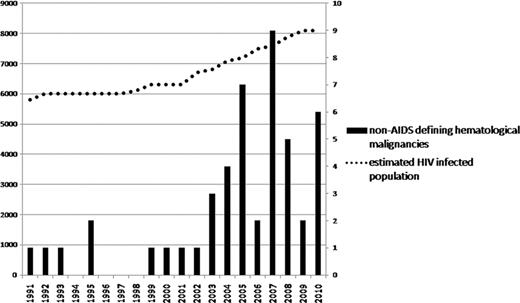Abstract
Abstract 2183
The prevalence of HIV infection is estimated to be less than 0.1% in Japan; however, the number of newly reported HIV-infected persons has gradually increased, and the estimated number of HIV-infected patients now ranges from 6300 to 10000. Since the introduction of highly active antiretroviral therapy (HAART), the morbidity and incidence of AIDS-defining cancers has decreased. However, the incidence of non-AIDS-defining cancers has increased in Japan. To elucidate the incidence and clinical outcome of non-AIDS-defining hematologic malignancies, excluding non-Hodgkin's lymphomas, in HIV-infected patients, we conducted a nationwide epidemiologic study.
We surveyed 429 regional AIDS centers and 497 educational hospitals certified by the Japanese Society of Hematology. Epidemiologic data for HIV was sourced from the Joint United Nations program on HIV/AIDS.
We obtained data from 511 institutes (55.4%). From 1991 to 2010, 47 cases of non-AIDS-defining hematologic malignancies were found—19 cases of Hodgkin's lymphoma (HD), 13 of AML, 7 of ALL, 4 of CML, 2 of multiple myeloma, 1 of CLL, and 1 of MDS-RAEB1. The mean age was 49.3 years (21–70 years), and 93.6% patients were male. The mean CD4-positive cell count was 303.7/μL (1–1371/μL). The mean duration from the diagnosis of HIV infection to hematologic malignancy was 45.0 months (0–204 months). Before diagnosis, 68.1% patients had been treated with HAART and 51.1% patients had AIDS. Sixteen of 19 HD patients were treated with ABVD or radiation therapy. Of these, 80% patients achieved complete remission, with a 2-year overall survival of 62.3%. Twelve of AML and 6 of ALL patients were treated with standard induction chemotherapy. Eight of twelve patients (66.7%) with AML and five of six patients (83.3%) achieved complete remission. The median survival for both AML and ALL patients was 16 months, with 42.8% ALL and 30.8% AML patients alive after 4 years. Comparison of the last 2 decades (1991–2000 and 2001–2010) showed a 4.7-fold increase in the incidence of hematologic malignancies (11.5 vs. 54.6/100000 person-years).
A nationwide epidemiologic study revealed that HIV-infected patients are at high risk of hematologic malignancies, and that the incidence of hematologic malignancies has increased in the past decade. The prognosis was equivalent to that of HIV-negative patients, and standard chemotherapy may be a feasible treatment option for HIV-infected patients with hematologic malignancies.
No relevant conflicts of interest to declare.
Author notes
Asterisk with author names denotes non-ASH members.


This feature is available to Subscribers Only
Sign In or Create an Account Close Modal